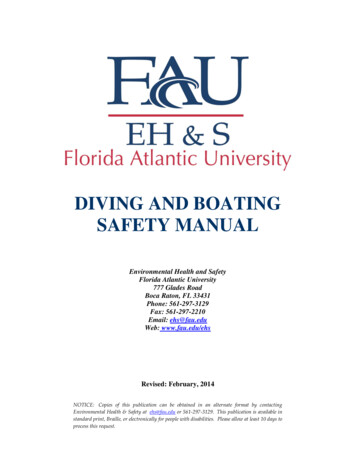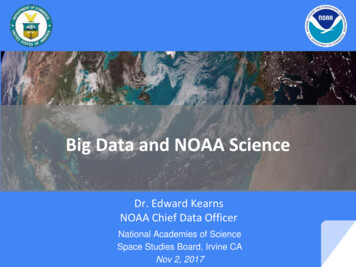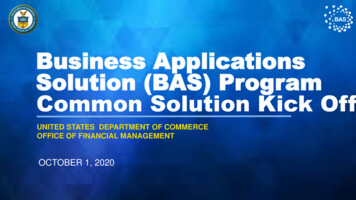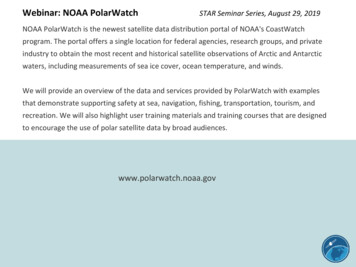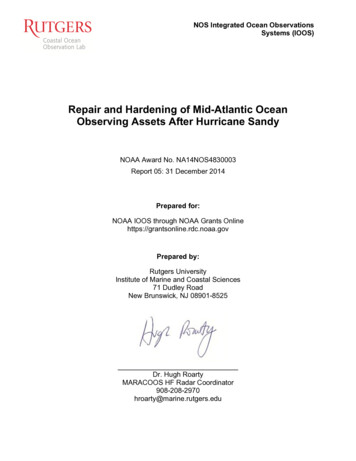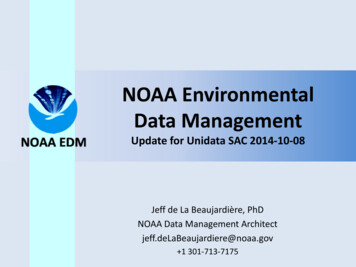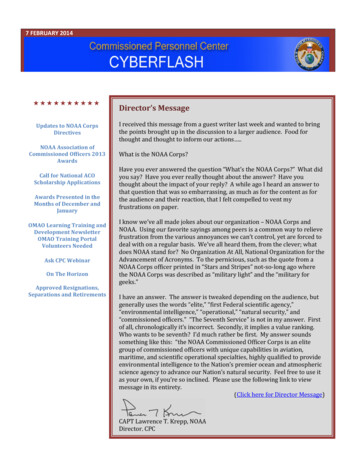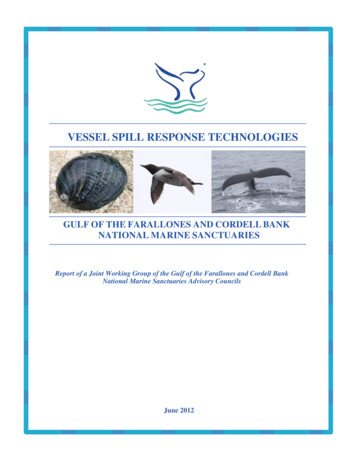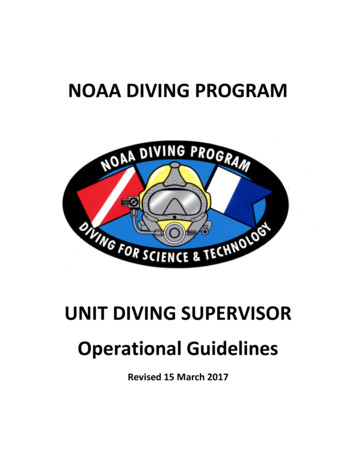
Transcription
NOAA DIVING PROGRAMUNIT DIVING SUPERVISOROperational GuidelinesRevised 15 March 2017Andrew W. David, Fisheries LODO
A Message from the NOAA Diving Control and Safety BoardThe Unit Diving Supervisor is the most important position in the NOAA Diving Program. You are the finalarbiter for all diving related activities at your unit: when dives occur, how the dives are executed, andwho goes in the water. You are also the conduit between the NOAA Diving Control and Safety Boardand your divers, explaining policies and procedures down the chain and elevating concerns and needsup the chain.Many things will be required of you as UDS. Some are tangible; others are intangible. The tangibleitems are listed in the following pages – which reports you need to complete, the forms required for arange of situations, etc. However the intangible requirements are far more important and impossible todefine in a manual. These skills are acquired over time, and require diligence, constant attention, andthe avoidance of complacency. Your decision making skills define your performance as a UDS. People’slives depend on the decisions you make. The toughest part of the job will be to maintain safety as yourhighest priority and not let friendships or pressure from project leaders or supervisors exert undueinfluence. You are not alone in this position, your LODO and the Safety Board will back you up on toughcalls. Use these resources often.The remainder of this manual is devoted to the tangible items you will use to administer the UDS duties.The UDS Manual begins with descriptions of the most common activities you will undertake as a UDS(e.g., how to file a dive plan, how to select Divemasters). Each report, form, or checklist is included inthis manual and prefaced with a description of when and how it should be used. These documents werecurrent at the time this manual was written, however please refer to the NDP website for the mostrecent versions. While there is a lot of information in this manual, it is not meant as a substitute for thestandards, policies and procedures in the NOAA Diving Standards and Safety Manual (NDSSM). Youshould have a copy and be familiar with the NDSSM and refer to it when you are uncertain how toproceed with any particular issue. The NDSSM is revised periodically, so policies that are draftedbetween revisions are codified through the OMAO 0300 series. These official policies are produced bythe NOAA Diving Control and Safety Board (NDCSB) and become effective after the Director, OMAOsigns them. The OMAO 0300 policies can be found on the NOAA Diving Program (NDP) website.Another resource you should utilize is your LODO. Remember your LODO works for you; they representyou on the NDCSB. If you have a problem or concern, raise it to your LODO.NOAA Diving Program, UDS Manual15 March 2017, Page i
Table of ContentsMessage from the NDCSB . iQuick Reference Guide of Dive Unit Schedules. 1Distinguishing Between OSHA-exepmt and OSHA-compliant Dives . 2Submitting a Dive Plan . 4Creating a new NOAA Diver . 6Reciprocity Divers . 11Observer Divers . 13Volunteer Divers . 15Safe Manning Levels . 19Choosing Divemasters and Lead Divers . 21Reporting Dive Incidents . 22Annual Report . 26Annual Inspections. 27Monthly Inspections . 29Annual Refreshers and Drills . 31Dive Unit Logbook . 32Performance Plan Language . 33NOAA Diving Program Documentation List . 35AdministrationDiving Incident Report Form, NF 57-03-01 . 37Diving Unit Annual Report, NF 57-03-02 . 38Diving Unit Safety Inspection (DUSA) Checklist, NF 57-03-03 . 43Diving Unit Change Form, NF 57-03-04 . 60Review for NOAA Diver Reciprocity, NF 57-03-05 . 62Letter of Reciprocity Request Form, NF 57-03-06 . 64Verification of Liability Coverage, NF 57-03-07 . 66Observer Diver Waiver of Liability, NF 57-03-08 . 66NDP Liability Release and Assumption of Risk, NF 57-03-09 . 71Agreement Approving Diving Operations from NOAA Owned or Contracted Vessel, NF 57-03-10 . 73NOAA Volunteer Diver Service Agreement, NF 57-03-11. 75NOAA Corps Officer Diving Authorization Request, NF 56-30. 78
Dive Operations and LogsDive Operations Plan, NF 57-03-20 . 80Diving Emergency Assistance Plan (DEAP), NF 57-03-21. 82Dive Operations Plan – Safe Ship, NF 57-03-22. 85Pre-Dive and Post-Dive Checklist, NF 57-03-23 . 88Monthly Dive Log, NF 57-03-24 . 90Supervisor Dive Log, NF 57-03-25 . 92Observer Diver Report, NF 57-03-26. 94Decompression Diving Request, NF 57-03-28 . 96Closed Circuit Rebreather (CCR) Decompression Diving Request, NF 57-03-29. 107Certification and TrainingAnnual Diver Training Record, NF 57-03-34 . 120Report of NOAA Skills Evaluation Checkout Dive, NF 57-03-35 . 122NOAA Diver Skills Checkout Checklist, NF 57-03-36. 125NOAA Diver Training Course, Student Evaluation Record, NF 57-03-37 . 128Training Request and Authorization Form, NF 57-03-38. 130Swim Test Evaluation, NF 57-03-39 . 132Annual Watermanship Assessment, NF 57-03-40 . 134Diving Activity Resume, NF 57-03-41 . 136Medical and Diving PhysicalReport of Physical Examination, NF 57-03-50, NF 57-03-51, NF 57-03-52 . 139Report of Medical History – Observer Diver, NF 57-03-53 . 148Report of Medical History – Annual Update, NF 57-03-54 . 150Standardized EquipmentSEP Measurement Form, NF 57-03-65 . 152SEP Transaction Form, NF 57-03-66 . 154SEP User Agreement, NF 57-03-67. 156Dive Computer User Agreement, NF 57-03-68 . 158NOAA-Owned Diving Equipment Off-Duty User Agreement, NF 57-03-69, NF 57-03-70. 161SEP Review of Property, NF 57-03-72 . 166
Cylinder Inspection, O2 Kit MaintenanceNOAA Visual Cylinder Inspection Report, NF 57-03-81 . 168NOAA Visual Cylinder Inspection Summary, NF 57-03-82 . 170Emergency Oxygen Kit Issue and Maintenance Checklist, NF 57-03-84 . 172Emergency Oxygen Kit Valve Test Results, NF 57-03-85 . 174
QUICK REFERENCE of DIVE UNIT SCHEDULESREPORTSExternal DUSA – Triennially, conducted by DSO and/or Inspectors from NDCAnnual Report – Due to LODO by 15 NovemberInternal DUSI – Due to LODO by 15 JanuaryEQUIPMENTSEP gear service – Annual, arrange timing with SEP CoordinatorSEP inventory check -- AnnualScuba cylinders visual inspection (VIP) – AnnualScuba cylinders hydrostatic inspection – Every five (5) yearsOxygen resuscitator kit function test – Monthly and before every diving dayOxygen regulator pressure test – Every three (3) monthsOxygen regulator service – BiannuallyAED inspection – Monthly for batteries, monitor pad expiration datesFirst Aid Kit medication replacement –As requiredDive computer service – AnnualNote: If manufacturer of any gear recommends shorter service/inspection intervals, follow themPERSONNELDive skills checkout dive – AnnualWatermanship test – AnnualRescue drills – AnnualTopside training – AnnualVerification of Coverage (contractors only) – AnnualAnnual medical history report – Due at the end of the month of the anniversary of last dive physicalDive physical – Every one to five (1-5) years, depending on ageNOAA Diving Program, UDS Manual15 March 2017, Page 1
Distinguishing Between OSHA-exempt and OSHA-compliant DivesOne of the most frequent decisions you will make as a UDS is the determination of which standards toapply to a dive – the NOAA standards for scientific dives or the OSHA standards for commercial(working) dives. Scientific dives require several conditions be met in order to be exempt from the OSHAStandards for Commercial Diving. The OSHA standards are found in 29 CFR 1910, subpart T. OSHAoffers the following definition of scientific diving: “Scientific diving means diving performed solely as anecessary part of a scientific, research, or educational activity by employees whose sole purpose fordiving is to perform scientific research tasks.”There are seven questions you should ask to help make this determination:1. Can the tasks be accomplished using simple hand tools (e.g., small hammers, pliers, chisels,wrenches, cameras, measuring tapes, nets, collection jars) weighing 25 pounds or lessunderwater?2. Do the tasks require the expertise of a scientist or scientist-in-training?3. Can the tasks be accomplished with minimal physical exertion?4. Can the tasks be accomplished in short duration (e.g., 1-hour)?5. Are the tasks limited solely to the observation of natural phenomena or responses of naturalsystems and/or gathering of data for scientific analysis?6. If any object is to be lifted or moved, is its weight underwater 100 pounds?7. Will the tasks result in the advancement of science?An answer of ‘NO’ to any of these questions means the OSHA standards for commercial (working) divesshould apply. Questions 1, 3, 4, 5, and 6 are fairly straightforward. While the one hour time limit inquestion 4 is easily defined, it is not a hard limit – the intent is to separate truly large projects fromsimpler ones. A scallop survey in a seagrass bed under 15 fsw that takes 90 minutes to complete is still ascientific dive. Questions 2 and 7 require your judgement and often can be the source of debate duringdive planning. Be realistic in assessing question 2, evaluate the task and think about the skills needed toaccomplish it. Does it really require scientific expertise? Let’s look at some examples: The task of diveone is to clean marine growth off two pilings so you can attach a tide gauge. Dive two requires theinstallation of a ‘No Fishing Zone” marker buoy anchor in a coral reef with minimal damage to livingcorals. Dive one is clearly a working dive, there is no scientific expertise needed to scrape barnacles offa piling. Dive two however, would qualify as a scientific dive because scientific expertise is required todetermine where the living corals are and the best location for the anchor to be installed withoutdamaging them.Question 7 also requires a realistic assessment of the task. Avoid over-reaching in an attempt to qualifyfor the scientific exemption. For example, dive three involves using a water jet to install a piling you willuse to tie up your 21 ft research vessel. The boat missions may advance science, but providing a placeto tie up the boat does not, this would be a working dive. Another type of dive which falls underquestion 7 is one involving education and outreach. These dives qualify for the scientific exemption ifNOAA Diving Program, UDS Manual15 March 2017, Page 2
they result in the advancement of science by promoting interest in NOAA’s scientific mission, increasingpublic awareness of ocean-related issues, or encouraging students to undertake a scientific career.If a dive combines scientific and working tasks, the working requirements take precedence and thecommercial standards apply. If dive two and dive three above were combined, the tasks were to installa mooring buoy in the reef without damaging corals and then the divers are to swim over to a sandyarea and install a piling, the commercial standards would apply.If you cannot make a determination, you should follow the more conservative approach and apply thecommercial standards. The primary differences are the manning levels and the requirement for analternate breathing gas supply.The NOAA Diving Standards and Safety Manual explains this subject in greater detail. Additionalinformation can be found in the OSHA standards, which are available at this how document?p table STANDARDS&p id 10139NOAA Diving Program, UDS Manual15 March 2017, Page 3
Submitting a Dive PlanSubmitting a dive plan is another common task you will perform as a UDS. There is a one-page formwhich is the administrative component of submitting a dive plan; Dive Operations Plan (NF 57-03-20).Once completed, this form should be submitted to the NDP.Diveplans@noaa.gov email address. Thefilename for the dive plan should be the UDS’ last name and the date, for ships it should be the shipname and the date (e.g., Roberson04July2017 or Pisces05Aug2017). One dive plan can cover severaldays or even weeks of a continuing project, as long as the operations are the same. It is also acceptableto have multiple tasks on one plan (e.g., dive 1 is to measure coral heads on a reef, dive 2 is an hourlater and the goal is to remove line from the rudder on the research vessel). However if the coral dive istoday and the ship husbandry dive is next week, submit two separate dive plans. In the case of aworking dive and a scientific dive on the same plan, you should check the working dive box as thatrequires stricter standards (although you could still use the scientific standards for the coral dive). Thereis no penalty for conducting a scientific dive under the working standards, but you do not want to go theother direction.While submitting the dive plan is simple, preparing the plan requires your full attention. The firstsection of the plan provides details of the diving operation, location, date, depth range, number ofdivers, etc. Occasionally there is confusion about the box for number of consecutive dive days. The firstday of diving does not count so begin incrementing the number in this box on the second day. Forexample, a two-day mission would have one consecutive dive day, a five-day mission would have fourconsecutive days. There are some checkboxes to indicate if the safe ship checklist or a float plan isrequired. The most important checkbox is the one describing the standards to be followed, scientific orworking. This determination is described in detail in an earlier section of this manual; if the plan willinclude both working and scientific dives, check the working dive box but indicate which dives will followthe scientific standards in the Purpose of Dives and Tasks to be Performed section.The Divers section is a simple list of the divers who may be involved with the dive. Include all divers, notonly the NOAA divers if there is a mixed team involved. It is helpful to list a little additional informationabout non-NOAA divers, such as T. Nugent (Univ. Detroit). The first person listed is the Divemaster orLead Diver for the operation. Match this person with the skills needed for the job. You may have anoperation to change zincs on a NOAA research vessel, a Divemaster who has overseen a thousand fishcounting dives and a NOAA Corps officer who did two hundred ship husbandry dives at her previousassignment. Choosing the Corps officer to be the Lead Diver for this mission would be a good decision.The next section has several boxes for narrative descriptions of the dive purpose, diver-worn equipmentand breathing gases, tools or special equipment needed, potential hazards and mitigations, and theplans for evacuating injured divers. In the hazards and mitigation box, you do not need to list commonhazards which are present on every dive (i.e., drowning, hypothermia, AGE, DCS). You should listhazards that are unique to this particular operation AND what steps you are taking to minimize theserisks. For example, the dive is to take place in a channel between a bay and the open ocean which issubjected to strong tidal currents and your mitigation is to dive at slack high or slack low tide.NOAA Diving Program, UDS Manual15 March 2017, Page 4
The final section is the authorization. Two people must sign the plan; one of them MUST be the UDS ortheir designee. The UDS (or designee) may be the originator of the plan, in which case a second divermay sign as the approving diver. The important thing is to have two different people review and signthe plan and one of them must be the UDS (or designee).The first time a plan is submitted in any calendar year, a copy of the Diving Emergency Assistance Plan(DEAP) (NF 57-03-21) should also be submitted. Also any time the circumstances of the DEAP change, anew plan should be submitted along with the dive plan. For example, a DEAP would change if therecompression chamber or hospital were different or if the evacuation method were different, say achange from government vehicle to helicopter, or from research vessel to ambulance. If you areplanning an operation in a location where another NOAA Dive Unit routinely operates, contact their UDSwhile preparing your DEAP; they will be able to provide their plan and save you time. They can alsoprovide local knowledge which will make your operation easier and safer.The Dive Operations Plan (NF 57-03-20) form is for the submission of no-decompression air or nitroxdives using open circuit or closed circuit equipment. These do not require approval by the NDCSB,however NOAA Diving Center (NDC) personnel review the plans to ensure the information on the formsis complete and the unit is properly planning their dives.There are different forms for decompression dives and mixed gas CCR dives. The Decompression DivingRequest (NF 57-03-28) must be submitted to the NDCSB and approved before any dives requiringdecompression. The Closed Circuit Rebreather (CCR) Decompression Diving Request (NF 57-03-29) mustbe submitted to the NDCSB and approved before any CCR dives using mixed gases (any breathing gasescomposed of more than 1% of an inert gas other than nitrogen) or requiring decompression. The Decoand CCR Deco forms are used infrequently and a detailed description of their use is not included in thisManual. If you need more information on these forms, please contact your LODO.NOAA Diving Program, UDS Manual15 March 2017, Page 5
Creating a new NOAA DiverThere are two avenues to follow for NOAA Diver Training based upon the location of the training. TheNOAA Diving Center offers three full-service, modular classes per year, two in Seattle and one in Florida.In addition the NDP allows for local training by approved NOAA Dive Trainers. Many of therequirements for the local and NDC training options are the same, however there are importantdistinctions in the prerequisites. There are also differences in the pre-approval process for FTEs andcontractors. Below is a step by step description of the process.NOAA Diver Training at the Unit Level with NOAA Dive Trainers – This program is designed to bringdivers with prior experience into the NOAA Diving Program. It is primarily a skills assessment andintroduction to the NOAA Diving Program policies and standards. Requirements to participate in thisprogram are certifications from a nationally recognized diver training organization (e.g., NAUI, PADI,IANTD, SDI/TDI) in Basic Openwater, Advanced Openwater and Rescue. A list of NOAA Dive Trainers canbe found on the NDP website.NDC Training Module Breakdown – The NDC has adopted a modular approach to its diver trainingprogram. There are now five (5) options to complete dive training at the NDC depending on the needsand experience of the diver. Additionally NDC offers NOAA Divemaster (DM), TetheredCommunications, and Diving Medical Technician (DMT) courses.Module 1 – Designed for divers with limited or no diving experience and is open to all diving candidateswith their UDS’s endorsement. Students learn how to scuba dive, receive training in rescue procedures,and learn the NOAA Diving regulations. Graduates are NOAA Divers able to conduct basic underwatertasks.Module 2 – Designed for previously certified recreational divers. Basic certification including 50 dives oran Advanced certification including 25 dives is required along with UDS endorsement. UDS endorsementmust include an in-water skills checkout dive by the UDS or designee. Graduates will be NOAA Diversable to conduct basic underwater tasks.Module 3 – Designed for any diver who has completed Module 1 or Module 2 or current NOAA Diversseeking additional skills and experience. Graduates will be able to conduct specialized underwater tasksincluding Core Skills and Special Task Endorsements (STEs).Module 1 & 3 – This combination is recommended for prospective ship’s divers or prospective scientificdivers who would like expanded working skills and mission support capabilities.Module 2 & 3 – This combination is the same as above but for previously certified divers.Divemaster – Designed for current divers who want to supervise diving operations. Prior divingexperience is required as is UDS endorsement.NOAA Diving Program, UDS Manual15 March 2017, Page 6
Tethered Communications – This training and the use of this equipment are primarily for the purpose ofreducing the number of personnel needed to conduct an OSHA designated working dive. A typicalworking dive requires five (5) people (in-water Buddy Team, Designated Person in Charge, pair ofStandby Divers), whereas Tethered Communications diving reduces that minimum requirement to three(3) people (in-water Diver, Tender, Standby Diver). Tethered Communications is a one (1) week coursetypically held once a year in Seattle, but can be done remotely or more frequently given a sufficientnumber of students.Dive Medical Technician – If you have multiple divers at your unit and are consistently conducting taxingdiving operations, this is an excellent program to send some of your divers through. This courseproduces graduates who are certified DMTs specializing in the recognition and treatment of divingmaladies. Completion of this course results in a NOAA DMT certification, however if specificallyrequested, a certificate from the National Board of Diving and Hyperbaric Medical Technology can beattained. Prerequisite for this course is a national EMT certification.Training Authorization – The first step is to ensure the diver candidate’s supervisor agrees to allowthem to participate in the program. This is done by completing a Training Request and AuthorizationForm (NF 57-03-38). For FTEs, the first line supervisor should sign the form. For contractors, thesupervisor from the contracting company should sign as well as the NOAA FTE for whom the contractemployee is providing services. Not all contracts or contract positions allow diving. Make sure theStatement of Work (SOW) in the contract and the diver candidate’s position description provide fordiving. The diver candidate and the UDS also sign the NF 57-03-38 form. NDC Training Courses havefees associated with them. Check with NDC or on their web site for the current fee schedule and includecosts and accounting codes on the NF 57-03-38. For local Dive Unit training by a NOAA Dive Trainer, theCourse and Payment Information section of NF 57-03-38 is left blank. For individuals who willparticipate in a NDC Training Course, the completed form is part of the application packet and must besubmitted 60 days in advance of the class. For those who will participate in local training at the DiveUnit level, the completed form must be retained in the diver’s file.Dive Physical – There are three forms required to secure medical clearance to dive, the first is a checklistdescribing the various tests (which are age dependent) and forms needed for a complete dive physicalpackage. The second item is a self-report of medical history and the third is a medical professional’sreport of a physical examination. These forms are combined in the Report of Physical Examination (NF57-03-50,51, 52). Before any physical activities are conducted (i.e., swim test, dive skills evaluation,checkout dives), the NOAA Diving Medical Officer (NDMO) must provide a medical authorization toproceed. A diver candidate’s medical insurance normally covers the cost of the laboratory tests andphysical exam, however if it does not, these costs may be covered by the government. The medicalhistory and physical exam forms contain private medical information which the UDS is not entitled tosee. However the UDS is very strongly encouraged to go over the checklist to ensure the package iscomplete before it is submitted to the NDMO. One of the most common delays in the diver certificationprocess is an incomplete dive physical. The diver candidate is responsible for submitting the diveNOAA Diving Program, UDS Manual15 March 2017, Page 7
physical package to the NDMO, this should be done by fax to (206) 529-2759 or encrypted email toDMO@noaa.gov.Swim Test – Once medically cleared, diver candidates must complete the Initial Swim Test with theresults documented on the Swim Test Evaluation (NF 57-03-39). There are three components to thistest; an underwater swim of 25 yds (22 m), a surface swim of 550 yds (500 m), and a 30 minute period oftreading water. The 550 yd swim must be completed without stopping and must use the front crawl,side stroke, or breast stroke. Goggles or a mask may be used on the swim, but no snorkels or fins. The550 yd snorkel must also be completed without stopping. The candidate may do the four componentsin any order, but
NOAA Diving Program, UDS Manual 15 March 2017, Page i. . systems and/or gathering of data for scientific analysis? 6. If any object is to be lifted or moved, is its weight underwater 100 pounds? . installation of a ZNo Fishing Zone marker buoy anchor in a coral reef with minimal damage to living corals. Dive one is clearly a working dive .
